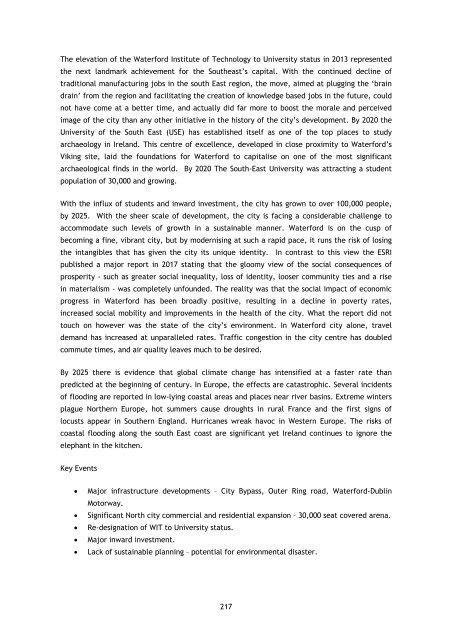TWICE THE SIZE - DIT Update - Dublin Institute of Technology
TWICE THE SIZE - DIT Update - Dublin Institute of Technology
TWICE THE SIZE - DIT Update - Dublin Institute of Technology
Create successful ePaper yourself
Turn your PDF publications into a flip-book with our unique Google optimized e-Paper software.
The elevation <strong>of</strong> the Waterford <strong>Institute</strong> <strong>of</strong> <strong>Technology</strong> to University status in 2013 represented<br />
the next landmark achievement for the Southeast’s capital. With the continued decline <strong>of</strong><br />
traditional manufacturing jobs in the south East region, the move, aimed at plugging the ‘brain<br />
drain’ from the region and facilitating the creation <strong>of</strong> knowledge based jobs in the future, could<br />
not have come at a better time, and actually did far more to boost the morale and perceived<br />
image <strong>of</strong> the city than any other initiative in the history <strong>of</strong> the city’s development. By 2020 the<br />
University <strong>of</strong> the South East (USE) has established itself as one <strong>of</strong> the top places to study<br />
archaeology in Ireland. This centre <strong>of</strong> excellence, developed in close proximity to Waterford’s<br />
Viking site, laid the foundations for Waterford to capitalise on one <strong>of</strong> the most significant<br />
archaeological finds in the world. By 2020 The South-East University was attracting a student<br />
population <strong>of</strong> 30,000 and growing.<br />
With the influx <strong>of</strong> students and inward investment, the city has grown to over 100,000 people,<br />
by 2025. With the sheer scale <strong>of</strong> development, the city is facing a considerable challenge to<br />
accommodate such levels <strong>of</strong> growth in a sustainable manner. Waterford is on the cusp <strong>of</strong><br />
becoming a fine, vibrant city, but by modernising at such a rapid pace, it runs the risk <strong>of</strong> losing<br />
the intangibles that has given the city its unique identity. In contrast to this view the ESRI<br />
published a major report in 2017 stating that the gloomy view <strong>of</strong> the social consequences <strong>of</strong><br />
prosperity - such as greater social inequality, loss <strong>of</strong> identity, looser community ties and a rise<br />
in materialism - was completely unfounded. The reality was that the social impact <strong>of</strong> economic<br />
progress in Waterford has been broadly positive, resulting in a decline in poverty rates,<br />
increased social mobility and improvements in the health <strong>of</strong> the city. What the report did not<br />
touch on however was the state <strong>of</strong> the city’s environment. In Waterford city alone, travel<br />
demand has increased at unparalleled rates. Traffic congestion in the city centre has doubled<br />
commute times, and air quality leaves much to be desired.<br />
By 2025 there is evidence that global climate change has intensified at a faster rate than<br />
predicted at the beginning <strong>of</strong> century. In Europe, the effects are catastrophic. Several incidents<br />
<strong>of</strong> flooding are reported in low-lying coastal areas and places near river basins. Extreme winters<br />
plague Northern Europe, hot summers cause droughts in rural France and the first signs <strong>of</strong><br />
locusts appear in Southern England. Hurricanes wreak havoc in Western Europe. The risks <strong>of</strong><br />
coastal flooding along the south East coast are significant yet Ireland continues to ignore the<br />
elephant in the kitchen.<br />
Key Events<br />
• Major infrastructure developments – City Bypass, Outer Ring road, Waterford-<strong>Dublin</strong><br />
Motorway.<br />
• Significant North city commercial and residential expansion – 30,000 seat covered arena.<br />
• Re-designation <strong>of</strong> WIT to University status.<br />
• Major inward investment.<br />
• Lack <strong>of</strong> sustainable planning – potential for environmental disaster.<br />
217








